DENTISTRY
WHAT IS COSMETIC DENTISTRY?
There is a common misconception that the sole purpose of cosmetic dentistry is to improve your smile by fixing the appearance of your teeth, but the practice is also concerned with boosting or restoring natural functionality and the correction of various dental problems. Cosmetic dentistry is a vast field with numerous procedures to solve problems like overbites, overjets, and other malocclusion issues; discolorations, gaps, chips, and cracks; and missing teeth.
In cases where discoloration is too severe, veneers are the ideal solution. At Sculptura Esthetic Dental Clinic, we use only the highest quality material to ensure final results that look and feel as natural as possible. Sculptura Esthetic Dental Clinic helps every patient maintain optimal dental health through extensive examinations and treatments that work. Every aspect of your oral health gets proper assessment and ultimately, resolution. Routine visits allow us to address problems before they worsen.
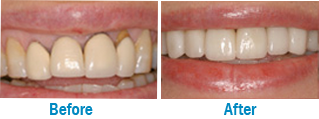
Cosmetic dentistry has fixed concerns regarding a patient that had porcelain fused to a metal crown from decades ago. In the past, dentists used to employ ceramic restorations that were stacked onto a metal substructure. Metal backing would often shine through and give a dark grey look around crowns. Now, non-metal base crowns are used so we can create a much more esthetic smile. In the photos on the left, you can see this dark hue which is overcome with all ceramic crowns in the “after” photos!
TOOTH WHITENING / BLEACHING
WHAT IS TOOTH WHITENING / BLEACHING ?
Teeth Whitening is the process of bleaching your teeth in order to make them appear whiter.
It can be done at home or best by a dentist, and is a purely cosmetic procedure.
WHAT ARE THE CAUSES OF YELLOW & DISCOLOURED TEETH?
Some of the factors that cause teeth to look yellow and discolored are:
- Smoking with by-products of tar and nicotine, leaves unsightly brown stains.
- Beverages such as tea and coffee will have the same effect over time.
- Teeth can naturally be a darker shade than desired due to heredity.
- Wearing braces or other dental apparatuses for extended periods of time will discolor enamel.
WHAT ARE THE METHODS TO WHITEN TEETH ?
Individuals have the option of using teeth whitening toothpastes, at-home bleaching methods or in-office bleaching methods.
- Whitening toothpastes remove stains from the surface of enamel by means of a mild abrasive; they do not change the color of the enamel. Whitening toothpastes contain a chemical that provides additional stain removal. Peroxide is one of the usual substances used. In over-the-counter formulas, peroxide is generally found at most to have a strength of 10%.
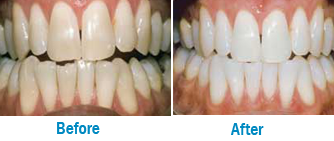
- Another option is the at-home method using bleaching gels and trays or mouth guards. A foam type tray is filled with the peroxide gel, placed over the upper or lower teeth, and worn for a specific amount of time; generally overnight or twice a day, for 1-2 weeks. This method also only removes stains. Enamel color is not changed. Occasionally soft gum tissue becomes irritated. These results are from using too much gel or from an improperly fitting tray. A custom fitted tray, obtained from a dental practitioner.
There are various ways to whiten your teeth, but the two most common are in-office treatment and the do-it-yourself approach, with over the counter products.
IN-OFFICE TEETH WHITENING
In-office teeth whitening involve a similar method - the peroxide gel a dentist uses has a much stronger concentration of peroxide. This gel contains 16% or more of peroxide. This specially formulated gel actually bleaches the enamel from the inside out. A protective gel is first applied to gum tissue to protect against irritation. Then the bleaching agent is applied to the teeth. A special light is used to enhance the chemicals in the bleaching formula. The process takes 30 minutes to 1 hour. More than one visit may be needed to whiten lower and upper teeth. Dentists advise that in certain instances enamel color may not significantly change, if teeth are extremely darkened.
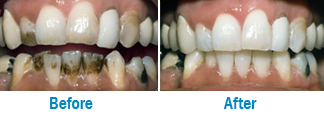
ARE THERE ANY SIDE EFFECTS DUE TO TEETH WHITENING?
A side effect of teeth whitening is the teeth’s sensitivity to air and exposure to extreme temperature changes, such as eating hot or cold foods. During the whitening process, enamel pores open, allowing these changes to penetrate and cause discomfort. Saliva contains minerals that aid in the healing process of closing pores by filling them, but this can be a timely process
TOOTH JEWELLERY
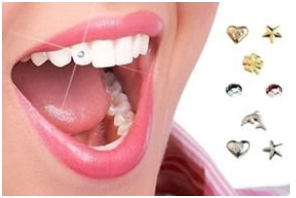
Body art is increasing in popularity within a fashion industry.It includes tattooing,body piercings & oral jewellery,which consists of soft tissue piercings and or objects attached to teeth.All body piercing presents a level of risk of infection.Because of the presence & variety of bacteria in the oral cavity,oral piercings are considered to have higher risk & are therefore strongly discouraged.But now a new craze is sweeping across the world that will make you shine like a star to really be glamorous,unique & fashionable,tantalize your teeth with top-quality tooth jewellery which is painless,no risk of infection & add sparkle to a smile.There are less document references available regarding this material so an effort is made to document about tooth jewellery.
Introduction:
Today, people are becoming increasingly self-conscious about their appearance and smile. They are looking for various treatments like body art and cosmetic dental treatments to achieve the desired aesthetic appearance, attention, to make a fashion statement and to be unique among the crowd. Body art includes tattooing, body piercings and oral soft tissue piercings. All body piercings presents a level of risk of infection, and are painful. Documented complications are related either to
- The jewellery (aspiration, allergy or chronic injury to adjacent teeth/ mucosa, including tooth fracture and gum recession, which can lead to tooth loss) or to
- the piercing procedure (local bleeding, swelling, nerve damage, toxic shock, permanent drooling, impaired sense of taste, or distant infections of the liver, heart or brain), tongue and lip piercings with metal barbell that interferes with speech, taste and mastication.
But, with the introduction of cosmetic dental treatments like porcelain veneering, composite veneering, bleaching and placement of tooth jewellery, patients smile can be made more pleasing, appealing, and aesthetic. This results in increased self confidence of the patient. Among these cosmetic dental treatments bleaching and veneering procedures are indicated for patients with discolored teeth, spacing between teeth, and mild irregular teeth, where as oral tooth jewellery is for all patients who wants a dazzling smile. The advantages of it being a temporary, painless procedure and it do not involve any invasive treatment on the tooth like drilling holes.
Types of tooth jewellery:
Tooth gems are crystals glass mounted on a thin foil of aluminum to create the attractive spark available in different colors.
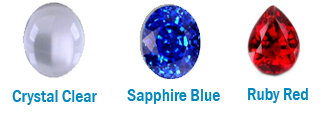

Brilliance tooth jewelry is available in 3 different colours crystal clear, sapphire blue, ruby red and is of two sizes - 1.8mm, 2.6mm Figure1. Rainbow crystals are the least expensive version of tooth jewellery. They’re ideally for short term attachment, to try the new service in your practice or for the customer with a smaller budget rainbow crystals are available in 10 different colors and two sizes (1.8mm and 2.5mm)
Twinkles are pure gold and precious stones like diamonds, sapphires and rubies in different shapes like
Diamond, Star, Triangle, Heart shape, Drop, Navette, & round shapes

Procedure & bonding instructions:
- The tooth is cleaned with a fluoride-free polishing paste.
- Completely dry and isolate the tooth.
- Tooth is etched with 37% orthophosphoric acid for about 20-30 sec to increase the surface area for bonding.
- Rinse surface thoroughly with water and blow dry for 10 sec. (no etchant should remain on the tooth.
- Apply a light-curing bonding agent. Leave it on for a maximum of 20 seconds, distribute bonding through air blowing.
- Then light-cure for 20 sec.
- Apply a small amount of flow composite to the surface of the tooth.
- Use a jewel handler to easily pick up the jewel. Press it into the center of the composite. (The composite must ooze on the sides so it is encircled by the composite, ensuring macro mechanical retention, but make certain the jewel is in contact with the enamel.)
- Now you may adjust the jewel while letting the patient check the desired positioning in the mirror.
- Take the light-curing lamp and start curing the composite from the top for about 60 seconds. Light cure from the sides for a few seconds and also cure the composite from the back of the tooth for another 60 seconds making sure the composite hardens evenly.
- Total curing time is approximately 180 seconds. (Follow instructions of the bonding-system you are using!
- The total time for jewel to set into the composite is 20 sec. Do not touch the jewel with your fingers once it’s removed from the case. To guarantee maximum adhesiveness, it is essential to avoid skin contact with the special coating on the backside of the jewel.
- It takes about 4 minutes to safely affix the jewel.
- The enamel is treated with topical fluoride to remineralize the etched area.
Removing the tooth jewel:
- The jewel is removed in the same way as an orthodontic bracket and the enamel will not be harmed.
- After removal of the gem, the tooth needs to be polished, which takes away any remaining bonding materials.
- Use a scaler or a rubber polisher when removing the stone. In case of leftover bonding or composite on the tooth, simply removeit by using a polishing tool. It is recommended to treat the tooth with fluoride, so remineralization and stabilization of the enamel is provided.
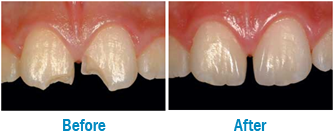
REPAIRING CHIPPED TEETH
Tooth bonding is used in several different ways, but is probably most useful for repairing chipped teeth. Bonding materials (high-density, space-age plastics called composite resin) and porcelain--are more natural in color and can be designed to perfectly match the surrounding teeth making it difficult to discern there ever was a broken tooth.
Transitional bonding is used for anything from a mock-up to a full-mouth rehabilitation. It’s called transitional because it allows the patient to transition into more permanent dentistry as he or she can afford, or as the treatment sequence demands, and it allows the dentist time to work out any bite related and esthetic issues. Transitional bonding is an important tool in the skillset of an accomplished cosmetic dentist.
VENEERS
Communication with your dentist about what you want corrected is critical for a successful result. Spend time clearly identifying what cosmetic improvements you want to accomplish.
The Hows and Whys of Porcelain Veneers
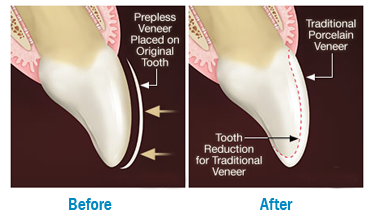
Porcelain laminate veneers consist of a compilation of several thin ceramic layers which replace original tooth enamel, and an adhesive layer. To apply a veneer, a very small amount of the original tooth enamel must be removed, usually less than a millimeter. This is essential as it creates room for the porcelain veneer to fit within the mouth and most accurately restore natural tooth function while creating an even better appearance than the original tooth.
The bond between original tooth and porcelain veneer is critical as it not only provides the esthetic perfection desired,but also a strong bond which is essential for correct veneer function. Light-sensitive resin is placed between the original tooth and the veneer and then hardened using a special curing light.
Porcelain veneers are a very successful option in many situations where the original tooth has developed poor color, shape, and contours. It is also a good choice for fractured teeth, gaps between teeth, and in some situations where the tooth position is compromised and there are minor bite-related problems. For some people, superficial stains do not respond well to tooth whitening or bleaching. In these situations, a porcelain veneer may be the best option.
Maintenance of a Porcelain Veneer
Maintaining porcelain veneers is actually quite simple:
Treat them as you would your original teeth,with routine brushing and flossing.Using non-abrasive fluoride toothpaste will typically be suggested by your dental professional.
You should also return to your dentist for regular professional maintenance because porcelain veneers should be polished with a specially formulated, non-abrasive paste & because your dentist needs to inspect your dentistry for any sign of potential failure.
DIRECT BONDING
Bonding is a popular treatment option because it provides a successful attachment between the filling material and the tooth’s original enamel and dentin. It looks like the original tooth and functions like it as well.
Direct composite bonding is used to recreate a smile in an additive manner, where little or no tooth reduction is needed. Direct bonding, in the hands of a skilled operator,is less costly than porcelain veneers and crowns and can be long-lasting with proper maintenance.
Enamel and Dentin
Teeth are a perfect combination of both strength and resilience and this is created through the fusion of enamel and dentin. Enamel is the outer shell of the tooth or the portion that is visible within the mouth. It is composed of densely packed calcium crystals which are very hard and resistant to wear. Enamel is composed of no living material and is effectively mimicked by dental porcelain. Dentin is the inner core of the tooth and is much more porous. Constructed of collagen tubes with calcium crystals, dentin is living tissue and transmits nerve sensation. Composite resins have properties similar to dentin and are a combination of a plastic resin and silica filler. This combination of materials allows for excellent tooth color replication and reliable adhesion.
BONDING TO REPAIR BROKEN OR CHIPPED TEETH
Tooth bonding is used in several different ways, but is probably most useful for repairing chipped teeth.Bonding materials (high-density, modern plastics called composite resin) and porcelain—are more natural in color and can be designed to perfectly match the surrounding teeth making it difficult to discern there ever was a broken tooth.
ROOT CANAL TREATMENT

Although pain killers are a very common way to combat toothache, they are not necessarily the best way. They don’t treat the cause – cavities that have destroyed the tooth structure to expose the pulp chamber of the tooth. Ignoring a cavity for long could turn into severe infection leaving you with no choice but to get your teeth removed
Treatment
Root canal treatment is essentially a dental procedure to save teeth which would otherwise need to be extracted. This treatment involves the removal of the tooth's damaged pulp - a small, thread-like tissue in the center of the tooth. Once the tooth's nerve tissue or pulp is damaged, it ceases to function. This cuts off blood supply to the tooth and the only course of treatment in such a case is to remove the damaged nerve or pulp and seal off the tooth, so that extraction can be avoided.
Causes
Although the reasons can be varied, a cracked tooth, deep cavity or tooth injury, are the most common causes for pulp damage. A root canal treatment needs to be done as soon as possible in order to avoid severe infection, which can harm the bone surrounding the root of the tooth apart from infecting surrounding areas. If the infected pulpal tissue is left untreated, pus can build up at the tip of the root in the jawbone, forming a tooth or a jaw abscess.
Procedure
The most important step before beginning the treatment is proper clinical diagnosis based on subjective as well as objective symptoms. During the root canal treatment, a dentist cleans up the pulp chamber and enlarges the canal. Once the pulpal tissue is removed, the remaining area is disinfected, medicated and obturated – filled with dental-filling. This procedure seals off the canal, preventing the spread of infection to other teeth.
Post Procedure
Because a root canal treatment removes the pulp from inside the tooth, the tooth becomes more brittle and may break more easily if it is not covered with a crown or cap. This is why dentists always advise to get the tooth capped after a root canal treatment.
Extraction v/s RCT
Though many people choose tooth extraction to root canal treatment, dentists the world over are of the opinion that root canal treatment is a much better option as compared to pulling out the tooth.
DENTAL IMPLANTS
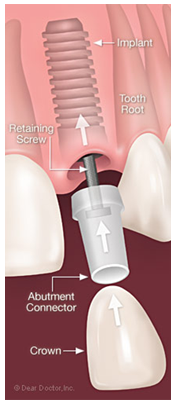
DENTAL IMPLANTS AND ROOTS
The key benefit of dental implants over other tooth replacement systems is that an implant connects directly to the jaw bone. It’s obviously not the same as the original connection, but functions just the same. When a tooth is lost, bone loss will eventually occur in that region because the root is no longer stimulating and stabilizing the bone. By using titanium--which biochemically joins to bone--to replace the root, you get a bond that more accurately replicates the one found in nature.
WHAT HAPPENS WHEN YOU LOSE A TOOTH?
you don’t need to replace it, since no one can see that it’s missing and you have plenty of other teeth. However, there is more bone loss going on under the surface once a tooth is lost. Surrounding each tooth is an alveolar bone that supports the tooth and when the tooth is lost, that bone basically melts away. This is why people who have lost most of their teeth and are not wearing dentures appear to have a caved-in appearance to their mouths.
Besides causing damage to the immediate area, tooth loss affects remaining teeth as well. Teeth create a structure for the face and their loss can shift the surrounding teeth, creating esthetic issues and bite problems. A lost tooth can also affect facial structures such as the jaw, muscles, jaw joints, and even the skin. If several teeth are lost, it’s not uncommon to suffer from social consequences and poor nutrition.
REBUILDING BONE
When the supporting alveolar bone melts away, it’s gone for good, but through grafting, a skilled dental professional can recreate bone to fuse with and support an implant. This is wonderful news, but it is still best to have a dental implant as soon as possible after the tooth is lost for the most predictable esthetic outcome.
DENTAL IMPLANTS VS. FIXED DENTAL BRIDGES
What Are Dental Implants?
Dental implants are actually a series of procedures used to recreate a missing tooth. The key part of a dental implant is the initial titanium implant which sits in the original tooth’s bone pocket, or alveolus. The titanium works well with the bone and actually forms a bond with it over time, much like the original bond between the tooth and the jaw bone. This is essential as it prevents bone loss that would normally occur with any other type of tooth replacement. Dental implants are capped with a crown, which replicates the enamel or visible portion of a tooth, and in many cases the replacement tooth will work just as well, if not better, than the original tooth.
What Is a Fixed Dental Bridge?
A fixed dental bridge is a non-removable prosthesis attached to remaining natural teeth The false tooth or teeth literally bridge the gap between natural teeth. For a long time, fixed bridges were the best alternative for people who had lost teeth, as they were quite successful and esthetically pleasing. Unfortunately, bridges can also present some problems because the natural teeth that lie on either side of the bridge are filed to accept the appliance. This step in the bridge-making procedure may make these teeth prone to bacterial plaque accumulations, decay, periodontal disease, and the possible need for future root canals.
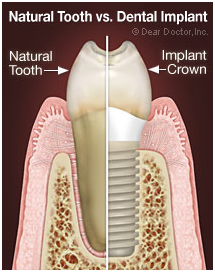
Cost Breakdown: Implant vs. Bridge
At first glance, it appears that a bridge is the more economical route, with total fees for a typical implant starting at the top end of the cost for a fixed bridge and ending a couple thousand dollars higher. But when comparing cost versus value, the dental implant is more cost-effective and the better treatment option – if the patient is a candidate for implants
PARTIAL DENTURES
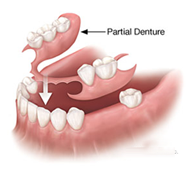
For many years, partial dentures have been used to replace groups of teeth or a few teeth scattered across the lower or upper jaw. There are a variety of removable partial dentures available to patients and each one comes with its own set of benefits and disadvantages. All partial dentures attach to remaining teeth and have a gum-colored portion meant to blend into the existing gum, with prosthetic teeth to replace the missing teeth.
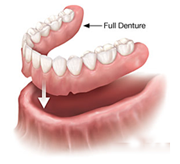
FULL DENTURES
Full dentures are similar to partial dentures in that they are prosthetic teeth and gums used to replace missing teeth. The main difference between full and partial dentures is that full dentures are a total replacement system for either upper or lower teeth and, in some cases, both.
Overdentures
Overdentures are a newer alternative to dentures,combining traditional denture technology with modern advancements in dental implants.
By establishing two implanted attachments to the lower jaw, an overdenture is able to sit securely in place to instantly increase retention, stability, and comfort. This is especially important in lower-jaw full-denture situations where traditional dentures tend to have less adhesion due to a limited foundation and the tongue muscle dislodging the prosthetic teeth.
Another benefit of overdentures compared to traditional dentures is the limited amount of bone loss where the implants are placed, making the procedure more successful in the long run and helping to preserve facial structural integrity.
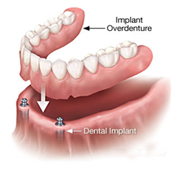
Overall, when considering full dentures for the lower jaw, an overdenture should be discussed with your dental professional as it can provide the most effective, satisfying, and longest-lasting alternative. Traditional full and partial denture options should be explored, weighing their benefits and pitfalls carefully to find the right dentures for your tooth loss.
PORCELAIN FIXED BRIDGES

Dental porcelain is remarkable in its ability to replicate both the form and function of original teeth. Whether you’re looking at veneers, crowns, or a fixed bridge, the use of porcelain can provide the longevity, durability, and esthetic you desire.
A porcelain fixed bridge is very useful when replacing a tooth or a couple of teeth that are no longer viable. The porcelain can be sculpted to replicate the look of natural tooth enamel and using this durable material gives your bridge a strong base to rely upon. Porcelain is so flexible in its design capabilities that it can be used not only to replace lost teeth, but also to improve the original appearance of those teeth and create a flawless replacement.
Porcelain Bridge Consultation
There are different ways to replace missing or damaged teeth, so a dental health professional should be contacted if this is a problem you are facing. Your teeth will carefully be examined and the right course of treatment will be pursued.

If you think a porcelain bridge is an avenue you want to explore, be certain you raise this with your AACD member dentist. He or she will explain the benefits of using porcelain and the few pitfalls you may run across. Make sure you express your concerns and if the main reason you’re seeking porcelain is cosmetic, don’t be ashamed to admit it; you will quickly discover that porcelain is excellent for esthetic reasons, but also has some highly desirable functional benefits as well.
The Hows and Whys of a Porcelain Fixed Bridge
A porcelain fixed bridge replaces missing teeth by using the surrounding teeth as a foundation. This creates a literal “bridge” between the remaining teeth and the missing teeth.
Dental porcelain is a great product because it can be shaped to replicate original teeth and fit comfortably within the established bite pattern. Porcelain is also very durable, will withstand most natural tooth functions, and can vividly mimic tooth enamel with its glass-like whiteness and translucence, which allows light to penetrate and scatter as it does with natural organic teeth.
Maintenance of a Porcelain Fixed Bridge
Maintaining a porcelain bridge is actually quite simple. Treat your bridge in the same manner as you would original teeth, with routine brushing with non-abrasive fluoride toothpaste and regular flossing.
A follow-up appointment will be scheduled to evaluate your bridge shortly after it’s placed, so the dentist can review his or her handiwork and see how your mouth is reacting to the treatment. Even if you think everything feels perfect, this appointment is vital to your future oral health.
ORTHODONTICS
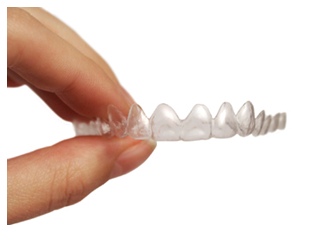
WHAT IS ORTHODONTICS / BRACES TREATMENT ?
Orthodontics is that branch of Dentistry in which crooked, irregular, protruding teeth & jaws are corrected with the help of various fixed and/or removable appliances, so that your smile looks better.When consumers think about orthodontics, braces are the first thing to come to mind. However, orthodontics is more than just braces. Orthodontists are concerned with the position of the teeth, what has caused them to arrive at their current position, and what future movement may be needed so that a patient’s bite is fully functional.
Your cosmetic dentist may have some orthodontic options available to straighten your teeth, ranging from conventional braces (with wires and brackets) to invisible braces (clear orthodontic aligners). Each method ranges in price and treatment length, and will vary by patient.
WHY SHOULD I GET ORTHODONTIC TREATMENT DONE ?
- Beauty, confidence & presentation are the three important pillars for overall success. Having irregular & protruding teeth is not attractive and in today’s day and age having a perfect smile reflects upon your overall personality and gives you that extra edge over your contemporaries.
- It becomes impossible to clean irregular & crooked teeth properly, as the result of which gums get infected and after some times teeth become loose & eventually they shed off
- Irregular teeth also cause impaired speech. These patients often are unable to pronounce some words clearly, particularly those starting from letter ‘S’, ‘T’, ‘P’, and ‘M’
- In some cases due to irregular teeth, patients are unable to chew their food properly which may lead to many gastric & digestive problems.
- These patients are more prone to associated diseases such as tonsillitis and sinusitis.
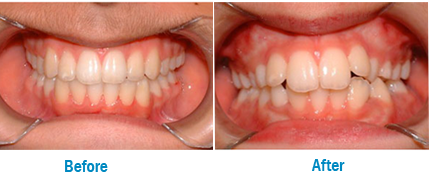
WHAT ARE THE TYPE OF BRACES AVAILABLE ?
Metallic Braces
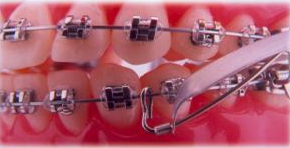
Ceramic Braces
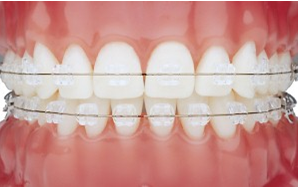
CLEAR ORTHODONTICS ALIGNERS
Clear orthodontic aligners can straighten a dental patient’s teeth without the wires and brackets of traditional braces. The aligners consist of a sequence of clear, removable trays that fit over the teeth to straighten them. Each tray must be worn by the patient for a specified amount of time—usually around 20 hours a day for two weeks--before the patient can progress to the next tray. In most situations, the aligners can straighten teeth in anywhere from six to 18 months.
Clear orthodontic aligners are suitable for patients with mild or moderate crowding, or minor spacing issues. They may not be appropriate for patients with severe crowding or spacing. While the aligners can correct a mild malocclusion, patients with severe underbites, overbites or crossbites may require more advanced orthodontic treatment.
Clear orthodontic aligners are suitable for patients with mild or moderate crowding, or minor spacing issues. They may not be appropriate for patients with severe crowding or spacing. While the aligners can correct a mild malocclusion, patients with severe underbites, overbites or crossbites may require more advanced orthodontic treatment.
Unlike traditional braces, the trays can be removed for brushing, flossing, and eating. Because the trays are clear, patients can undergo this type of orthodontic treatment without the usual discomfort associated with regular braces.


